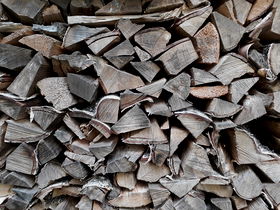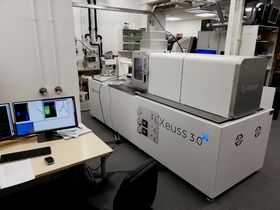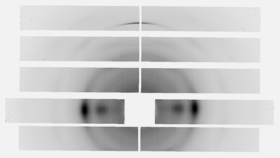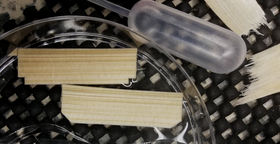Biobased Materials Structure
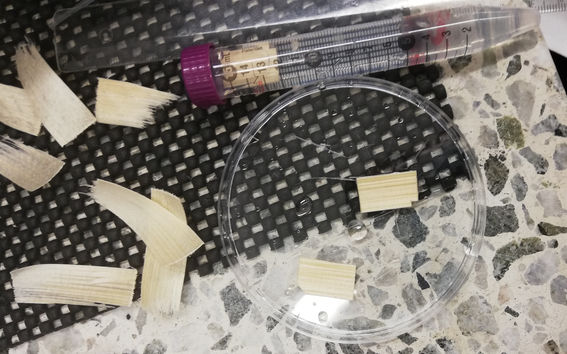
Research topics
-
Nanoscale structural characterization of biobased materials
-
Development of X-ray and neutron scattering data analysis
-
Wood nanostructure and moisture interactions
News and events
- Welcome to our new postdocs Afrina Khanam and Sromona Nandi!
- Our first doctoral researcher Aleksi Zitting defended his thesis on November 15, 2024
- Group leader Paavo Penttilä received the Hayashi Jisuke award by The Cellulose Society of Japan, see news item
Ongoing research projects
Neural networks for X-ray scattering analysis of wood materials (NNxWOOD)

This Academy of Finland Research Fellow project (2021–2026) aims to develop new machine learning based methods for analysing X-ray scattering data from wood materials. A detailed picture of the structure of wood cell walls is highly desired to accelerate the development of new, sustainable applications from this abundant renewable raw material. Recently developed imaging techniques based on X-ray scattering offer unprecedented possibilities for studying the hierarchical structure of wood, but the development of new automated procedures for the data analysis is necessary.
Follow on X (Twitter): #NNxWOOD
Automatized reconstruction of wood cell wall nanostructure from X-ray scattering patterns (WoodCensus)
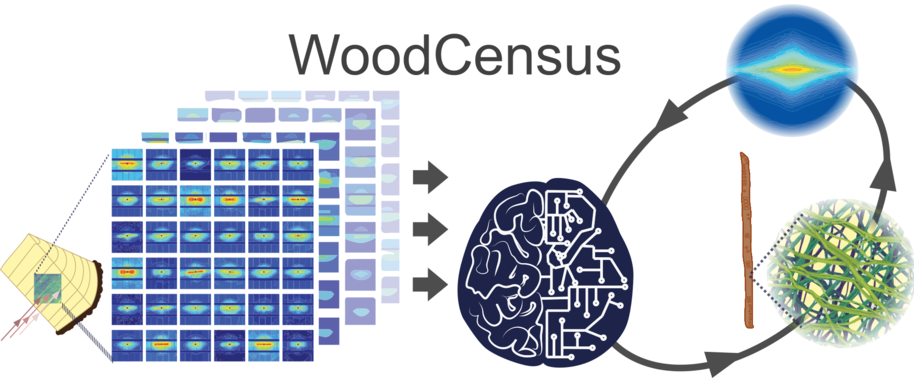
This collaborative project between our group and VTT Technical Research Centre of Finland is funded by the Research Council of Finland for 2024–2026. The project develops a workflow for automatized analysis of small-angle scattering data from wood materials. The method generates three-dimensional reconstructions of the cell wall nanostructure based on scattering patterns. It aims to make the use of scattering methods more efficient, to digitalize the nanostructure of wood cell walls, and to promote the utilization of high-performance computing in the field of bio-based materials.
SmartRecovery – Scattering methods for lignin analysis
This project develops methods based on the scattering of X-rays and light to study the structure of lignin particles. Our aim is to make these methods capable of characterizing structures formed by lignin efficiently and with as simple sample preparation as possible, and to yield new fundamental information on the structure of lignin particles. The project is a collaboration with VTT Technical Research Centre of Finland and funded for 2023–2024 by Business Finland. Read more about the project on the Expand Fibre webpage and in a blog text about our visit to the MAX IV synchrotron.
Related publications:
- Characterisation of lignin microparticle size with static light scattering, J. Makkonen, Master's thesis, Aalto University (2024)

Past research projects
Simulation-assisted scattering analysis of moisture-induced swelling in wood microfibril bundles (SASAMIS)
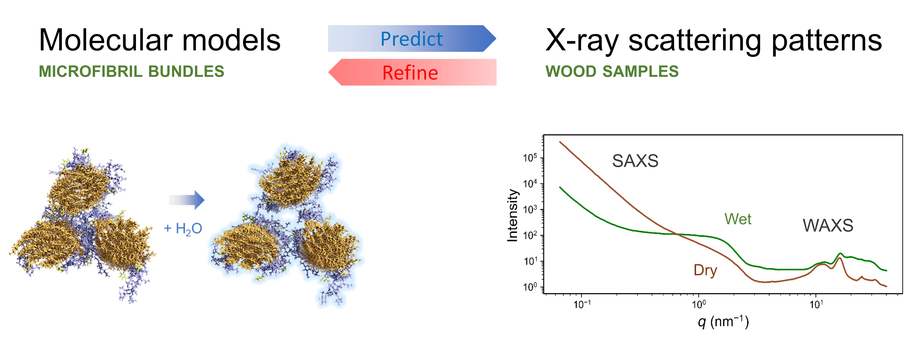
This project was a collaboration between our group and VTT Technical Research Centre of Finland, funded by the FinnCERES Flagship of the Research Council of Finland (2019-2023). By coupling molecular simulations with tailored scattering measurements of wood samples, we improved the resolving power of both methods and gained fundamental information on the nanoscale structure and moisture behaviour of wood. Read more on the FinnCERES webpage.
Related publications
- Role of lignin in moisture interactions of cellulose microfibril structures in wood, Zitting, A., Paajanen, A., Altgen, M., Rautkari, L., & Penttilä, P.A., Small Structures, 5, 2400167 (2024).
- Impact of hemicelluloses and crystal size on X-ray scattering from atomistic models of cellulose microfibrils, Zitting, A., Paajanen, A., & Penttilä, P.A., Cellulose, 30, 8107-8126 (2023).
- Nanoscale mechanism of moisture-induced swelling in wood microfibril bundles, Paajanen, A., Zitting, A., Rautkari, L., Ketoja, J.A., & Penttilä, P.A., Nano Letters 22, 5143-5150 (2022).
- Deswelling of microfibril bundles in drying wood studied by small-angle neutron scattering and molecular dynamics, Zitting, A., Paajanen, A., Rautkari, L., & Penttilä, P.A., Cellulose 28, 10765-10776 (2021).
- Combining scattering analysis and atomistic simulation of wood-water interactions, Penttilä, P.A., Paajanen, A., & Ketoja, J.A., Carbohydrate Polymers 251, 117064 (2020).
- Investigating moisture behavior of wood nanostructure using experimental and simulated scattering, Doctoral thesis of Aleksi Zitting (2024)
- Blog text "A powerful combination to explain nanoscale wood-water interactions" in the FinnCERES blog and a related video on YouTube
Understanding the moisture behaviour of wood in nanoscale (WooD2O)

This postdoc project funded by the Academy of Finland (2018-2021) studied how the nanoscale structure of wood responds to moisture changes and how water is involved in the hierarchical structure of wood. The location of water inside of the wood cell wall and effects caused by moisture changes were studied especially using small-angle neutron and x-ray scattering.
Related publications
- Nanoscale mechanism of moisture-induced swelling in wood microfibril bundles, Paajanen, A., Zitting, A., Rautkari, L., Ketoja, J.A., & Penttilä, P.A., Nano Letters 22, 5143-5150 (2022).
- Water-accessibility of interfibrillar spaces in spruce wood cell walls, Penttilä, P.A., Zitting, A., Lourençon, T., Altgen, M., Schweins, R., & Rautkari, L., Cellulose 28, 11231-11245 (2021).
- Deswelling of microfibril bundles in drying wood studied by small-angle neutron scattering and molecular dynamics, Zitting, A., Paajanen, A., Rautkari, L., & Penttilä, P.A., Cellulose 28, 10765-10776 (2021).
- Combining scattering analysis and atomistic simulation of wood-water interactions, Penttilä, P.A., Paajanen, A., & Ketoja, J.A., Carbohydrate Polymers 251, 117064 (2020).
- Bundling of cellulose microfibrils in native and polyethylene glycol-containing wood cell walls revealed by small-angle neutron scattering, Penttilä, P.A., Altgen, M., Awais, M., Österberg, M., Rautkari, L., & Schweins, R., Scientific Reports 10, 20844 (2020).
- Moisture-related changes in the nanostructure of woods studied with X-ray and neutron scattering, Penttilä, P.A., Altgen, M., Carl, N., van der Linden, P., Morfin, I., Österberg, M., Schweins, R., & Rautkari, L., Cellulose 27, 71-87 (2020).
Follow on X (Twitter): #WooD2O
Comprehensive characterization of wood structure from nano- to mesoscale using small-angle neutron and X-ray scattering
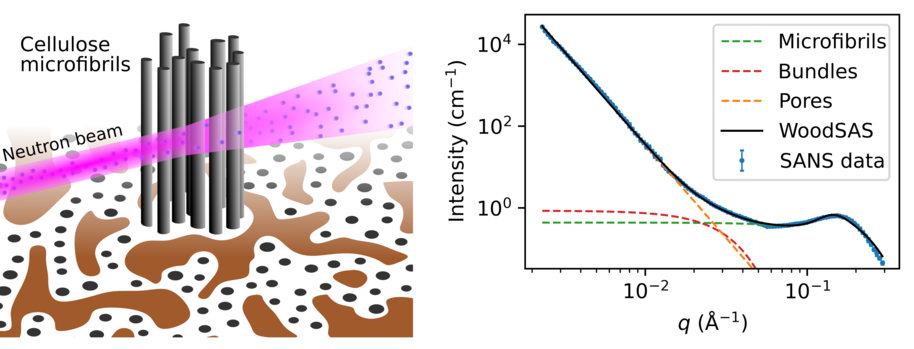
This postdoc project, mainly funded by Emil Aaltonen foundation (2017-2018), developed small-angle scattering data analysis for wood samples. It resulted in the freely-available WoodSAS model, which can be used to analyse small-angle neutron and X-ray scattering (SANS, SAXS) data from wood.
Related publications
- Small-angle scattering model for efficient characterization of wood nanostructure and moisture behaviour, Penttilä, P.A., Rautkari, L., Österberg, M., & Schweins, R., Journal of Applied Crystallography 52, 369-377 (2019).
- Bundling of cellulose microfibrils in native and polyethylene glycol-containing wood cell walls revealed by small-angle neutron scattering, Penttilä, P.A., Altgen, M., Awais, M., Österberg, M., Rautkari, L., & Schweins, R., Scientific Reports 10, 20844 (2020)
Members

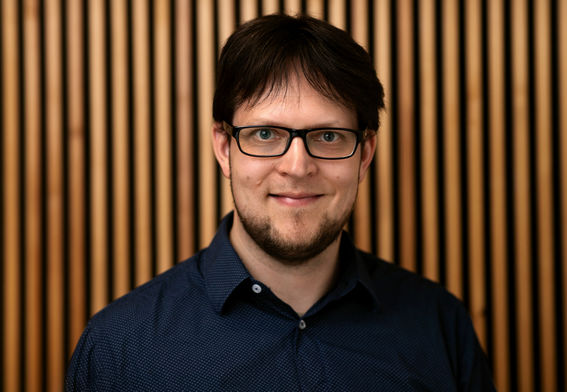
Academy of Finland Research Fellow Paavo Penttilä
Dr. Penttilä graduated with a PhD from the University of Helsinki, Department of Physics in 2013, with a specialization in X-ray and neutron scattering. After spending in total four years as a postdoc at Kyoto University (Japan) and the Institut Laue-Langevin (France), he started as a postdoc at Aalto University in 2018. The Academy of Finland granted him Postdoctoral Researcher funding for 2018-2021, and then Research Fellow funding for 2021-2026. Dr. Penttilä holds the Title of Docent in Experimental Materials Physics, awarded by the University of Helsinki.
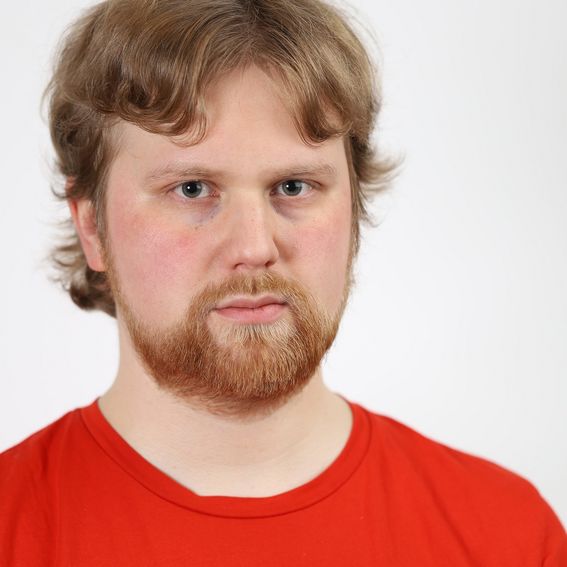
Postdoctoral Researcher Patrik Ahvenainen
I studied computational and materials physics at the University of Helsinki, Department of Physics. I received my doctoral degree in 2016, focusing on studying wood and other plant materials with X-ray methods. After graduating, I received a two-year post-doctoral research grant from Kone Foundation for studying wood used in electric guitars. Before joining Aalto, I worked three years as a 3D Imaging Specialist at Planmeca where I developed algorithms for 3D reconstruction and image processing for dental and medical imaging devices. I joined Paavo Penttilä's research group in September of 2022 to continue my research on wood and other lignocellulosic materials.
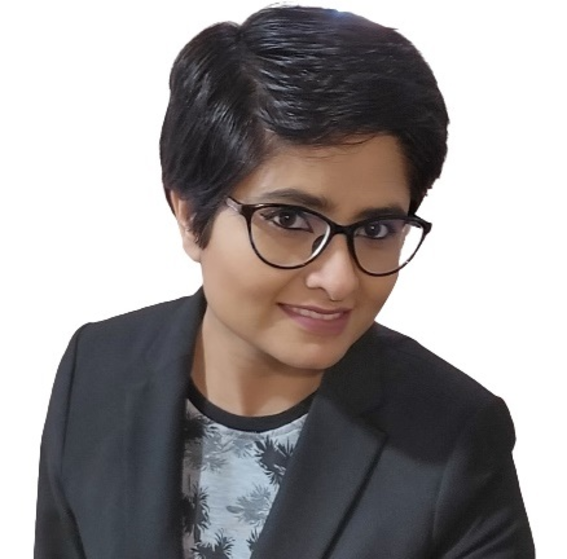
Postdoctoral Researcher Afrina Khanam
I graduated with a Master’s degree in Nuclear and Particle Physics from the University of Jyväskylä in the year 2017. My Master’s thesis was focused on analyzing Nuclear Astrophysical phenomena utilizing DigiDAC system and Cyclotron facilities at IGISOL. I earned a PhD in 2023 from the Department of Applied Physics at Aalto University. My Doctoral research was concentrated on the point defect analysis of group IV and compound thin-film nano-semiconductor materials applying positron annihilation spectroscopy technique. In November 2024, I joined the Biobased Material Structure group, where my current research involves sample preparation and synchrotron experiments of the NNxWOOD project that deals with analyzing tissue-specific nanostructures of wood cell walls. Additionally, I am engaged in the CELNAS project to study the degradation of fabrics employing SAXS and WAXS measurements.

Doctoral Candidate Enriqueta Noriega Benitez
I studied space physics, including solar particle detection and simulations of such particles, at the University of Turku, where I received my Master's degree in Chemical and Physical Sciences in 2021. In February of 2022, I joined Paavo Penttilä’s research group at Aalto University in which we probe the structure of bio-based materials, chiefly wood, through the use of X-ray scattering techniques and machine learning algorithms. Currently, my work in the NNxWOOD project focusses on processing X-ray scattering data with an AI-based approach to analyze the nanostructure of wood.
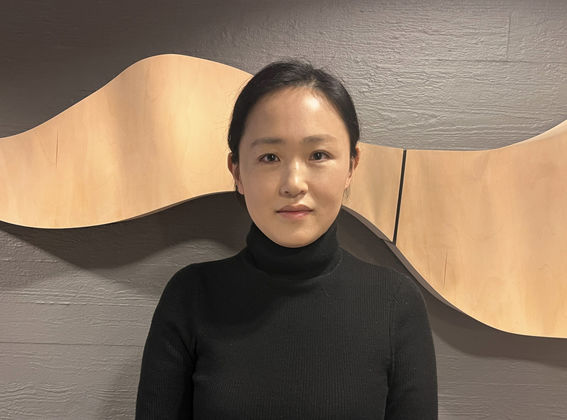
Doctoral Candidate Cui Yin
I graduated with a Master's degree in Physical Chemistry from China University of Mining and Technology, where I specialized in chemical reaction kinetics. In August 2024, I began my research as a doctoral candidate in the Biobased Materials Structure group. My project focuses on small-angle scattering analysis of cellulose fibers and their interactions with moisture. I am conducting specific analyses of the scattering contributions from different structural components in pulp fibers and developing methods to interpret small-angle scattering data from these cellulosic materials.
Former group members
Aleksi Zitting (doctoral researcher 2019-2024, currently at Chalmers University of Technology)
Janita Makkonen (master's student 2024, currectly at VTT)
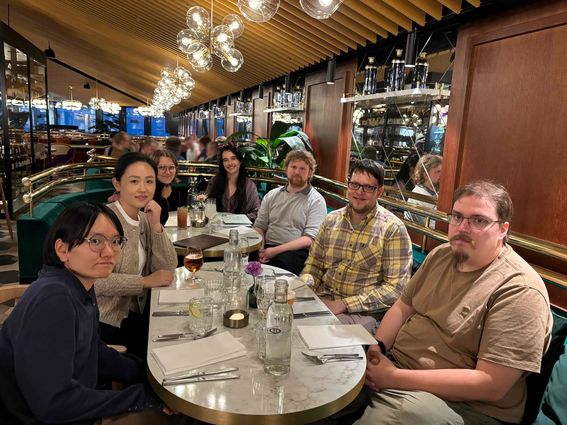
How to join us?
Highly motivated MSc, doctoral or postdoctoral students interested in joining the group can contact Dr. Paavo Penttilä (firstname.lastname@aalto.fi).
Teaching
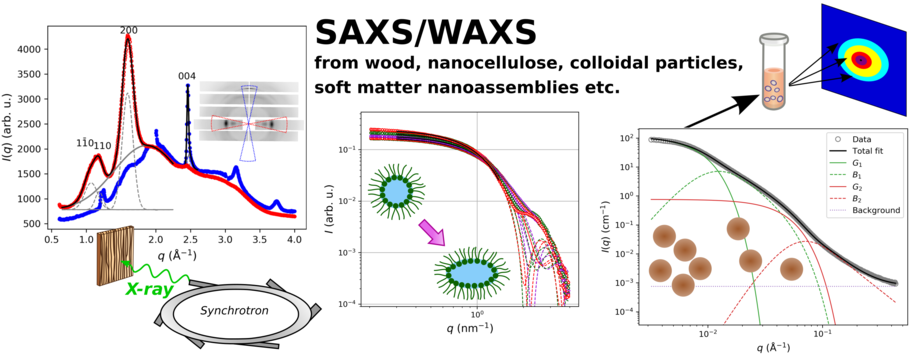
Dr. Penttilä was teaching the course “X-ray scattering methods for structural analysis of bio-based materials” in 2020-2024. The target of the course was to introduce doctoral and advanced Master’s students to X-ray-based structural characterization methods (both in theory and in practice) and initiate the application of these methods in the students’ own research. The course has been discontinued.
Collaborators
Our group has ongoing collaborations with researchers from Aalto University (Finland), VTT Technical Research Centre of Finland (Finland), University of Helsinki (Finland), Institut Laue‒Langevin (France), Kyoto University (Japan), MAX IV Laboratory (Sweden), and Technical University of Munich (Germany).







